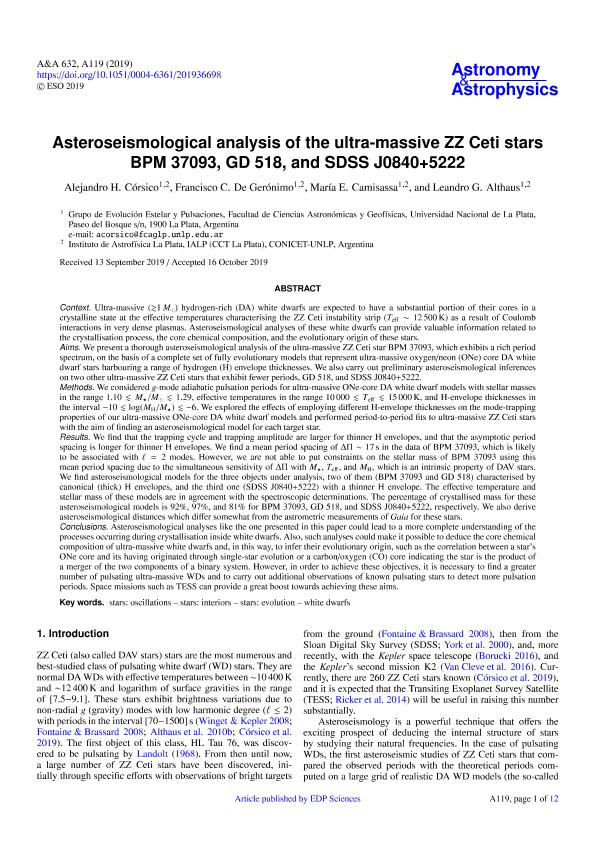Mostrar el registro sencillo del ítem
dc.contributor.author
Corsico, Alejandro Hugo

dc.contributor.author
de Gerónimo, Francisco César

dc.contributor.author
Camisassa, María Eugenia

dc.contributor.author
Althaus, Leandro Gabriel

dc.date.available
2021-02-10T02:45:48Z
dc.date.issued
2019-12-13
dc.identifier.citation
Corsico, Alejandro Hugo; de Gerónimo, Francisco César; Camisassa, María Eugenia; Althaus, Leandro Gabriel; Asteroseismological analysis of the ultra-massive ZZ Ceti stars BPM 37093, GD 518, and SDSS J0840+5222; EDP Sciences; Astronomy and Astrophysics; 632; A119; 13-12-2019; 1-12
dc.identifier.issn
0004-6361
dc.identifier.uri
http://hdl.handle.net/11336/125254
dc.description.abstract
Context. Ultra-massive (≳1 M⊙) hydrogen-rich (DA) white dwarfs are expected to have a substantial portion of their cores in a crystalline state at the effective temperatures characterising the ZZ Ceti instability strip (Teff ∼ 12 500 K) as a result of Coulomb interactions in very dense plasmas. Asteroseismological analyses of these white dwarfs can provide valuable information related to the crystallisation process, the core chemical composition, and the evolutionary origin of these stars. Aims. We present a thorough asteroseismological analysis of the ultra-massive ZZ Ceti star BPM 37093, which exhibits a rich period spectrum, on the basis of a complete set of fully evolutionary models that represent ultra-massive oxygen/neon (ONe) core DA white dwarf stars harbouring a range of hydrogen (H) envelope thicknesses. We also carry out preliminary asteroseismological inferences on two other ultra-massive ZZ Ceti stars that exhibit fewer periods, GD 518, and SDSS J0840+5222. Methods. We considered g-mode adiabatic pulsation periods for ultra-massive ONe-core DA white dwarf models with stellar masses in the range 1.10 ≲ M⋆/M⊙ ≲ 1.29, effective temperatures in the range 10 000 ≲ Teff ≲ 15 000 K, and H-envelope thicknesses in the interval −10 ≲ log(MH/M⋆)≲ − 6. We explored the effects of employing different H-envelope thicknesses on the mode-trapping properties of our ultra-massive ONe-core DA white dwarf models and performed period-to-period fits to ultra-massive ZZ Ceti stars with the aim of finding an asteroseismological model for each target star. Results. We find that the trapping cycle and trapping amplitude are larger for thinner H envelopes, and that the asymptotic period spacing is longer for thinner H envelopes. We find a mean period spacing of ΔΠ ∼ 17 s in the data of BPM 37093, which is likely to be associated with ℓ = 2 modes. However, we are not able to put constraints on the stellar mass of BPM 37093 using this mean period spacing due to the simultaneous sensitivity of ΔΠ with M⋆, Teff, and MH, which is an intrinsic property of DAV stars. We find asteroseismological models for the three objects under analysis, two of them (BPM 37093 and GD 518) characterised by canonical (thick) H envelopes, and the third one (SDSS J0840+5222) with a thinner H envelope. The effective temperature and stellar mass of these models are in agreement with the spectroscopic determinations. The percentage of crystallised mass for these asteroseismological models is 92%, 97%, and 81% for BPM 37093, GD 518, and SDSS J0840+5222, respectively. We also derive asteroseismological distances which differ somewhat from the astrometric measurements of Gaia for these stars. Conclusions. Asteroseismological analyses like the one presented in this paper could lead to a more complete understanding of the processes occurring during crystallisation inside white dwarfs. Also, such analyses could make it possible to deduce the core chemical composition of ultra-massive white dwarfs and, in this way, to infer their evolutionary origin, such as the correlation between a star’s ONe core and its having originated through single-star evolution or a carbon/oxygen (CO) core indicating the star is the product of a merger of the two components of a binary system. However, in order to achieve these objectives, it is necessary to find a greater number of pulsating ultra-massive WDs and to carry out additional observations of known pulsating stars to detect more pulsation periods. Space missions such as TESS can provide a great boost towards achieving these aims.
dc.format
application/pdf
dc.language.iso
eng
dc.publisher
EDP Sciences

dc.rights
info:eu-repo/semantics/openAccess
dc.rights.uri
https://creativecommons.org/licenses/by-nc-sa/2.5/ar/
dc.subject
stars: oscillations
dc.subject
stars: interiors
dc.subject
stars: evolution
dc.subject
white dwarfs
dc.subject.classification
Astronomía

dc.subject.classification
Ciencias Físicas

dc.subject.classification
CIENCIAS NATURALES Y EXACTAS

dc.title
Asteroseismological analysis of the ultra-massive ZZ Ceti stars BPM 37093, GD 518, and SDSS J0840+5222
dc.type
info:eu-repo/semantics/article
dc.type
info:ar-repo/semantics/artículo
dc.type
info:eu-repo/semantics/publishedVersion
dc.date.updated
2020-11-19T21:56:30Z
dc.journal.volume
632
dc.journal.number
A119
dc.journal.pagination
1-12
dc.journal.pais
Francia

dc.description.fil
Fil: Corsico, Alejandro Hugo. Universidad Nacional de La Plata. Facultad de Ciencias Astronómicas y Geofísicas; Argentina. Consejo Nacional de Investigaciones Científicas y Técnicas. Centro Científico Tecnológico Conicet - La Plata. Instituto de Astrofísica La Plata. Universidad Nacional de La Plata. Facultad de Ciencias Astronómicas y Geofísicas. Instituto de Astrofísica La Plata; Argentina
dc.description.fil
Fil: de Gerónimo, Francisco César. Universidad Nacional de La Plata. Facultad de Ciencias Astronómicas y Geofísicas; Argentina. Consejo Nacional de Investigaciones Científicas y Técnicas. Centro Científico Tecnológico Conicet - La Plata. Instituto de Astrofísica La Plata. Universidad Nacional de La Plata. Facultad de Ciencias Astronómicas y Geofísicas. Instituto de Astrofísica La Plata; Argentina
dc.description.fil
Fil: Camisassa, María Eugenia. Universidad Nacional de La Plata. Facultad de Ciencias Astronómicas y Geofísicas; Argentina. Consejo Nacional de Investigaciones Científicas y Técnicas. Centro Científico Tecnológico Conicet - La Plata. Instituto de Astrofísica La Plata. Universidad Nacional de La Plata. Facultad de Ciencias Astronómicas y Geofísicas. Instituto de Astrofísica La Plata; Argentina
dc.description.fil
Fil: Althaus, Leandro Gabriel. Universidad Nacional de La Plata. Facultad de Ciencias Astronómicas y Geofísicas; Argentina. Consejo Nacional de Investigaciones Científicas y Técnicas. Centro Científico Tecnológico Conicet - La Plata. Instituto de Astrofísica La Plata. Universidad Nacional de La Plata. Facultad de Ciencias Astronómicas y Geofísicas. Instituto de Astrofísica La Plata; Argentina
dc.journal.title
Astronomy and Astrophysics

dc.relation.alternativeid
info:eu-repo/semantics/altIdentifier/url/https://www.aanda.org/10.1051/0004-6361/201936698
dc.relation.alternativeid
info:eu-repo/semantics/altIdentifier/doi/http://dx.doi.org/10.1051/0004-6361/201936698
Archivos asociados
